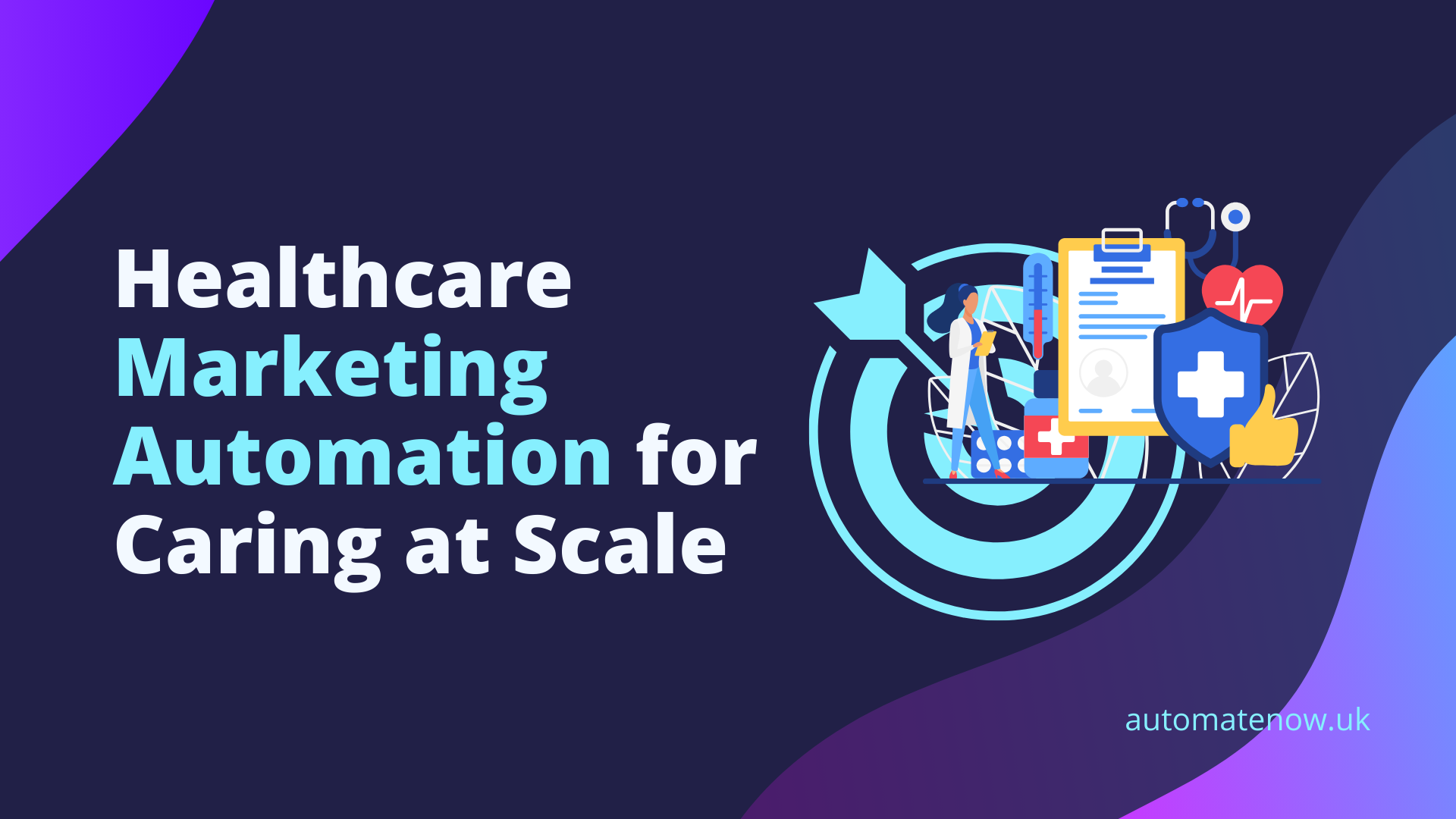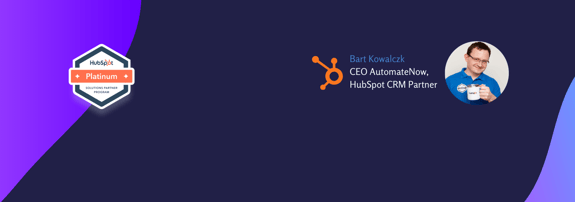Optimize, Personalize, and Increase Patient Satisfaction, with Marketing Automation for the Healthcare Industry
What exactly is marketing automation, and why is it so critical for the healthcare industry, specifically?
Simply put, it's the process of using software and technologies to help savvy healthcare organizations automate repetitive tasks.
That's the super basic answer, of course - and we both know you're here for more than that! Yes, healthcare marketing automation can quickly streamline your to-do list, but the benefits of healthcare marketing automation go above and beyond.
If you want to expand your reach or grow your practice faster, we’ve got the goods.
From email marketing tools to marketing automation software, planning effective marketing campaigns, to lots of tips, tricks, and strategies to improve patient engagement, read on to find out how you can stand apart from your peers.

The Benefits of Marketing Automation in Healthcare Services
Let's talk for a moment about why having the right marketing processes in place is so important for the healthcare sector.
Manual marketing alone often can't keep up with the demands of efficiently acquiring the sheer volume of patients needed for sustainable revenue growth.
But with the right tactics, healthcare automation software can automate fairly repetitive activities, from check-up reminders, happy birthday emails, to reminding patients to update their electronic health records where necessary that can make your patients feel appreciated and cared for.
These activities can become automated marketing strategies to increase patient engagement, boost retention rates, and help healthcare companies to better serve their customers.
With that in mind, the right marketing software can help you with:
- Educating and nurturing prospective patients by delivering targeted, relevant content over time, with things like email automation.
- Avoiding overwhelming patients with irrelevant messages that don't address their needs or concerns.
- More efficiently and accurately qualifying prospective patients, helping you progress them through automation programs or workflows that are tailored to their needs.
- Increasing your marketing teams' overall productivity by removing repetitive administrative tasks, enabling staff to focus on patient retention, not their to-do list.
Your overarching objectives should be:
-
Empowering teams to efficiently create and manage more prospective patients than with manual processing or marketing efforts alone.
-
Nurturing those people with personalized emails or other marketing and social media content to encourage conversion.
-
Ultimately compounding traditional healthcare marketing efforts, and delivering the right information at the right time.
In a nutshell: automation is the best way to scale showing your patients that you care, in real-time.
Boost Patient Engagement and Streamline Patient Acquisition
When you first start exploring how best to use automation in healthcare marketing campaigns, begin by mapping out an ideal patient experience.
Then, when you automate your marketing solutions, you're more focused on patient insights and their needs, which you can then use to create content touchpoints that are both timely and relevant.
Think about your entire digital healthcare marketing mix: emails, apps, web pages, or chatbot conversations: everything you're putting out there is an opportunity to convert your target audience.
Personalized Messages for Lasting Patient Relationships
As marketing teams everywhere know, you have to try and make whatever you do personal to your patient, and integrate their needs with your targeted messages.
This is equally true for healthcare, and we know that thinking about automating your marketing initiatives can seem daunting, but really, it's a bit like going on a treasure hunt.
When you blend that patient experience exercise above with personalized messages, you start to uncover the key triggers and stages that can be automated in the form of specific, nuanced sequences or workflows.
Common automation triggers/opportunities include:
-
Clicking on links within nurture emails multiple times, indicating interest.
-
Downloading gated assets like eBooks, fact sheets, or how-to healthy lifestyle tips.
-
Initiating conversations via live chat or site messaging.
Still a bit confused?
Let's look at some examples of triggers:
- Your trigger is set as 'multiple clicks on a nurture email'.
- A prospective patient clicks on a nurture email several times.
Once that trigger kicks in (hello, email automation!) any number of tools can take over:
- Set a reminder to make a call the next day about their area of interest.
- Offer to book them in for a check-up via email.
- Send over a digital leaflet about getting winter-ready.
Still stuck? Think about the needs of your patients based on predetermined behaviors, and go from there.
The Right Message at the Right Time?
While marketing automation platforms can unlock huge opportunities, they can also negatively impact marketing campaigns, customer experience, and otherwise sabotage your patients' perceptions of you.
You must check that your automation service provider (if you're in the US!) is HIPAA compliant, and takes appropriate patient data protection measures. Data protection regulations are serious business, and rightly so.
Beyond the sensitivity and security aspects of this work, you have to use marketing automation capabilities in a personal way. There's no point in working hard to optimize marketing efforts if you make these basic mistakes.
So what are the key things to watch out for and avoid?
Sending the same content to everyone
Don't you just hate it when you get the same vanilla, spammy content as everyone else out there? You know what we mean - the emails that have nothing to do with your interests, the ones that show up with bland messages and truly terrible stock photos.
While automation is a powerful tool, you have to make sure you put effort into thinking about your patients. Identify trends, consider health surveys, and subjects that are specific to their needs and interests, not what's easiest for you.
Not having enough quality content
You've probably gathered that when it comes to content, quality trumps quantity every time - but one of the risks that you could run is not having a decent quantity of quality content. Take the time to develop and create a suite of helpful eBooks, guides, and more - and watch as this simple step helps your marketing campaigns to reach the right people.
By putting in processes to capture content throughout each month or quarter, you lift the burden of having to generate new assets when there's a sudden dip in revenue. Oh, and if you're using AI as a single-step process to generate that content, well, the market is going to give you what you deserve.
When you don't gain insights into your patients' behaviors
This mistake is going to cost you, big time! Understanding your customers is the number one priority when it comes to successful engagement. If you don't understand your customer, it doesn't matter how great your marketing automation is, those thoughtfully written, intelligent messages could go to the inbox of someone who hates going to the doctor!
Don't fall into the trap of wasting valuable time chasing people who aren't ready or just aren't a good fit for your practice, when you could be fostering great relationships with people who do need what you offer.
Focusing on your patient's needs should be your number one priority. If it isn't, change that.
Sending content at the wrong time
Beyond sending out bland, porridge-flavored content to people who aren't interested, you could be committing another sin - sending content at the wrong time!
You know what people probably don't need on a hectic Monday morning when they're only halfway through their coffee and their eyes aren't open yet? Another dull, irrelevant, ‘blah’ email that clogs up their inbox and irritates them.
When are your prospects opening your emails? For some folks that could be 4pm on a Friday, for others it might be 2pm Tuesday. Collect and analyze open rate data, and then align your content-timing and internal processes accordingly.
Not writing in a way that’s engaging, accessible, or readable
We've established just how much content is a crucial part of every healthcare engagement strategy, right? While your content might look sharp and jazzy from a visual perspective, we've got another angle to consider - can people actually read and engage with what you've written?
There are some instances when a photo will do more than five paragraphs of content ever will - but often the medical terms, long Latin names, pharmacy jargon, and inside phrases mean nothing at all to your patient.
Could someone who wasn't a doctor or a resident easily understand this? If the answer's no, do some editing.
Need A Healthcare Automation Tool? Make Data-Driven Decisions
With everything we've talked about so far, hopefully it's evident that finding the right automation software for your industry is crucial to your success. You've seen just how much marketing automation helps when it comes to the healthcare landscape. Underpinning that, having the right marketing platform can take your efforts to a whole new level and help you stand out.
Now, we're maybe a little bit biased, but we do think that HubSpot is the most effective automation platform out there. Yes, lots of other tools can help, but a platform like HubSpot really does give you a headstart when it comes to robust automation technology.
And despite what some software companies or healthcare marketing agencies say, you don't need 20 tools when you can use just one to drive revenue growth. Not only does HubSpot help you to nurture and support potential patients, but it has everything you need for a full marketing automation strategy.
Customer Relationship Management for Healthcare Providers
Remembering the importance of quality content, HubSpot has a suite of tools to help take your marketing from good to great. As an all-in-one automation platform, HubSpot uses its Smart CRM data, so you can send tailored content experiences, based on factors like location, need, and more.
Other platforms, like Marketo or MailChimp, offer similar services, but HubSpot's advantage for healthcare providers lies in its focus on user behavior.
For example, if you want to kickstart success, new HubSpot users can use pre-built work flow templates for common lead nurturing scenarios.
In HubSpot, healthcare marketing teams can also promote multiple aspects of your practice, and leverage existing automated processes to help boost your conversion rate.
Once you've laid a solid foundation, you can then iteratively test how your contacts interact with messages: analyzing patient feedback to continually optimize every touchpoint. The result? Services based outreach that's personalized for your patients - rather than sending generic irrelevant content that frustrates and alienates them, instead.
Marketing Automation for Healthcare - Let's Summarize!
As we've seen - marketing automation tools are critical for healthcare professionals to efficiently generate and build relationships, using a Smart CRM that gathers and makes the most of patient feedback.
By automating repetitive tasks like lead scoring and email sequencing, healthcare companies get more time back in their diaries to build and nurture those all-important real-life relationships.
Your goal with automation is to empower teams to acquire and care for more new patients than with manual efforts alone, nurture prospects to encourage conversion, and ultimately drive growth and retention.
To leverage automation, start by first mapping your prospective patient's healthcare journey. This reveals key triggers and stages that you can use as feedback - like multiple clicks on emails or downloading assets. Work flows, sequences and more can then provide targeted follow-ups via email, SMS, chatbots, and so on.
Remember, your high-quality content assets are essential for automation success! Content should aim to attract and educate patients, actively build positive relationships, and address health-related concerns - so continually test and optimize your content based on engagement data to boost conversion.
Above all, if all of this sounds overwhelming, don't worry. While automation tools can help, getting used to them can take some time - and having someone in your corner to help you discover the best solution can make all the difference. You can book a demo with us here - and in the meantime - happy automating!





